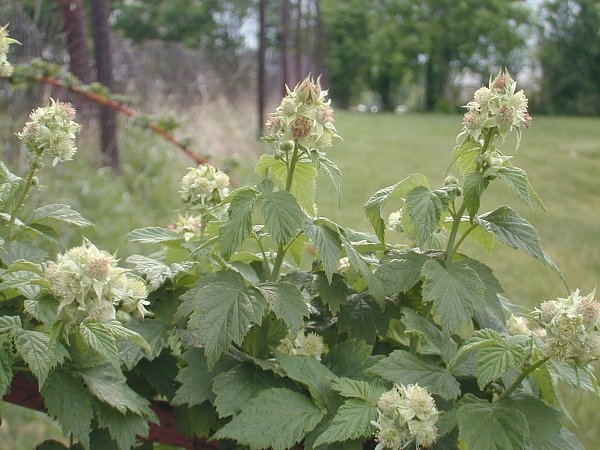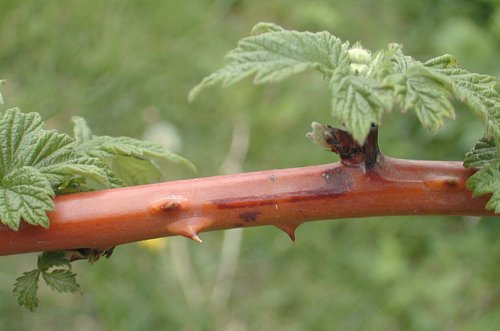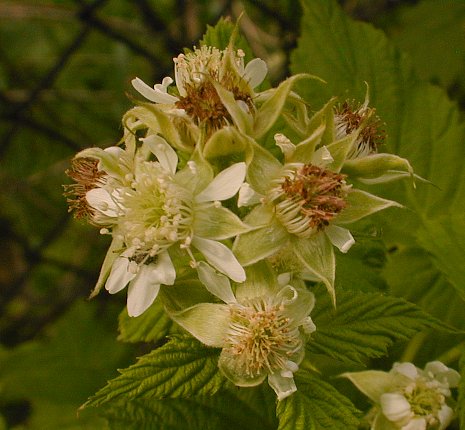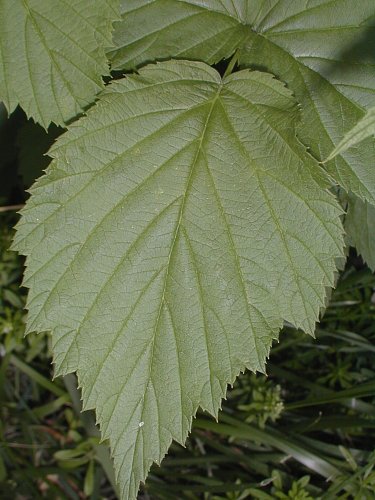Description: This perennial shrub produces little-branched canes up to 6' long during the first year. These canes are initially erect, but they eventually arch sideways and downward – their tips sometimes reach the ground. First-year canes are vegetative and do not produce flowers and fruit. They are initially green, hairless, and glaucous, but later turn brown and woody during the winter. Scattered along the length of each cane are prickles that are short and curved. During the second year, these canes develop short branches that terminate in erect cymes or short racemes of flowers. Along the length of these canes, there are alternate compound leaves. These compound leaves are usually trifoliate; rarely are they palmate with 5 leaflets. The leaflets are up to 3" long and 2" across. They are cordate-ovate or ovate in shape and doubly serrate along the margins; some leaflets may be shallowly cleft. The upper surface of each leaflet has strong pinnate venation, while its lower surface is white tomentose (covered with white hairs that are very short and appressed). The terminate leaflet has a short slender petiole, while the lateral leaflets are sessile, or nearly so.

The flowers are bunched tightly together on the cymes/racemes. Each flower is about ½" across, consisting of 5 white petals, 5 green sepals, and numerous stamens that surround the multiple green carpels and their styles. The petals are elliptic or oblong, while the sepals are triangular-shaped and spreading; the petals are about the same length as the sepals. The blooming period occurs during the late spring or very early summer and lasts about 2-3 weeks. Each flower is replaced by a compound drupe that is ovoid and about 1/3" long when fully mature. This compound drupe is initially white, later becomes red, and finally turns black-purple when it is mature. Each drupe consists of multiple drupelets, each drupelet containing a single seed. The fleshy drupes are sweet and slightly tart in flavor; they detach cleanly and easily from their receptacles. The root system consists of a woody branching taproot. Vegetative offsets are often produced by the canes rooting at their tips.

Cultivation:
The
preference is partial sun, moist to mesic conditions, and rich loamy
soil. In areas that are too sunny and dry, the fruit may not develop
properly without adequate rain. The canes also fail to set fruit if
there is too much shade.
Range & Habitat:
The native Black Raspberry is common in central and northern Illinois,
but
somewhat less common in the southern area of the state (see Distribution
Map). Habitats include openings in deciduous woodlands,
woodland borders, savannas, thickets, fence rows, overgrown vacant
lots, powerline clearances in wooded areas, and partially shaded areas
along buildings. Black Raspberry adapts well to human-related
disturbance; it also occurs in higher quality natural areas.

Faunal
Associations:
The nectar of the flowers attracts bees primarily, including honeybees,
bumblebees, mason bees (Osmia
spp.), leaf-cutting bees (Megachile spp.),
cuckoo bees (Nomada spp.),
Halictid bees, and Andrenid bees. The short-tongued bees also collect
pollen from the flowers. Less often, small butterflies and skippers may
visit the flowers for nectar. Because raspberries are economically
important, insects that feed on the foliage, stems, and fruit are
fairly well known. These insect feeders include the larvae of metallic
wood-boring beetles, larvae of long-horned beetles, leaf beetles, plant
bugs, stink bugs, aphids, leafhoppers, treehoppers, katydids,
walkingsticks, larvae of sawflies, larvae of Geometer moths, larvae of
midget moths (Nepticula spp.), larvae of owlet moths (Noctuidae),
larvae of Tortrix moths, and larvae of a butterfly, the Striped
Hairstreak (Satyrium liparops strigosum). The Insect Table
provides additional information about these species. The fruit of both
raspberries and blackberries is an important source of food for many
upland gamebirds, songbirds, and woodpeckers (see Bird Table). Various
mammals also use Black Raspberry (Rubus occidentalis) and other Rubus spp.
as sources of food. Their fruits are eaten by the American
Black Bear, Gray Fox, Red Fox, Virginia Opossum, Raccoon, Fox Squirrel,
Least Chipmunk, Eastern Chipmunk, White-footed Mouse, Woodland Jumping
Mouse, and Meadow Jumping Mouse; the mice also cache and eat the seeds.
The American Moose, Elk, White-tailed Deer, and Domesticated Goat
browse on the foliage and canes of these plants; the Cottontail Rabbit
also browses on their canes(Romain et al., 2013; Martin et al., 1951/1961;
Schneider et al., 2006; Whitaker, 1966; Whitaker & Mumford, 1970;
Hamilton, 1941; Blackmore, 1998). The birds and mammals eating the
fruits spread the seeds of these plants to new locations. Raspberries
and blackberries also provide excellent nesting habitat and protective
cover for various kinds of wildlife. Black Raspberry is often used by
the Field Sparrow as site for its nests (Best, 1978).
Photographic Location:
Along a fence row at the web master's apartment complex.

Comments: While the flowers of Black Raspberry are not very showy, the fruit has excellent flavor and is rather colorful. The prickly canes are unpleasant to walk through or mow around, although less so than many species of blackberries. While both raspberries and blackberries are members of the same genus (Rubus spp.), the drupes of raspberries detach cleanly and easily from their receptacles, while the drupes of blackberries do not. Other native raspberries in Illinois produce drupes that are red at maturity, rather than black-purple. When drupes are unavailable for observation, Black Raspberry can be identified by the following features: 1) the white petals of its flowers are narrow, rather than broad and overlapping, 2) its compound leaves are usually trifoliate, rather than palmate with 5 or more leaflets, 3) its leaflets are white-tomentose on their undersides, rather than some shade of green, and 4) young vegetative canes often have a white bloom that can be rubbed off (i.e., they are glaucous).